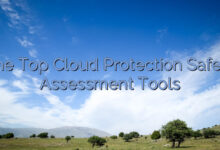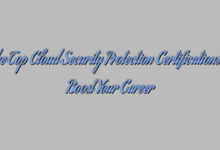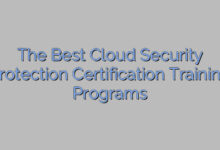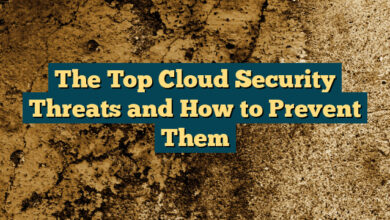The Top Best Practices for Cloud Security Architecture
Contents
- 1 Introduction
- 1.1 What is Cloud Security Architecture?
- 1.2 Why is Cloud Security Architecture Important?
- 1.3 The Importance of Best Practices for Cloud Security Architecture
- 1.4 The Strengths and Weaknesses of Best Practices for Cloud Security Architecture
- 1.5 Best Practices
- 1.6 FAQ
- 1.6.1 1. What is Cloud Security Architecture?
- 1.6.2 2. What are the key goals of cloud security architecture?
- 1.6.3 3. What is the role of authentication in cloud security architecture?
- 1.6.4 4. Why is data encryption important for cloud security architecture?
- 1.6.5 5. What is key management, and why is it vital for cloud security architecture?
- 1.6.6 6. What is penetration testing, and why is it important for cloud security architecture?
- 1.6.7 7. How can organizations maintain secure configuration in cloud security architecture?
- 1.6.8 8. Who should be responsible for implementing cloud security architecture?
- 1.6.9 9. How often should security audits be conducted in cloud security architecture?
- 1.6.10 10. What are the potential risks of implementing cloud security architecture?
- 1.6.11 11. How can organizations ensure they maintain compliance with regulatory requirements?
- 1.6.12 12. How can organizations ensure they are implementing granular access controls?
- 1.6.13 13. How can organizations ensure they are conducting regular penetration testing?
- 1.7 Conclusion
- 1.8 Disclaimer
Introduction
Visitors, welcome to our article discussing The Top Best Practices for Cloud Security Architecture. With the increasing use of cloud computing, it is important to secure data and ensure the safety of personal information. In this article, we’ll go over some best practices that can be utilized to enhance cloud security.
What is Cloud Security Architecture?
Cloud security architecture refers to the design and implementation of security measures to protect data stored on cloud platforms. It includes the use of technologies and procedures to manage security risks and protect the confidentiality, integrity, and availability of data.
Why is Cloud Security Architecture Important?
As more companies shift to using cloud platforms for data management, they become more vulnerable to potential cyber-attacks. This makes it mandatory to enforce rigorous security measures to protect data from cyber-attacks, data loss, and unauthorized access. Effective cloud security is crucial to ensure the security and privacy of sensitive information stored on cloud platforms.
The Importance of Best Practices for Cloud Security Architecture
Effective cloud security measures should consist of several standards and best practices. By implementing these best practices, companies can strengthen their security posture and minimize risks of potential data breaches. This article will discuss some of the top best practices to help companies achieve optimal cloud security.
The Strengths and Weaknesses of Best Practices for Cloud Security Architecture
Before we delve into the best practices of cloud security architecture, it’s important to understand their strengths and weaknesses:
Strengths:
The following are some benefits to implementing best practices for cloud security architecture:
- Reduced risk of data breaches
- Increased transparency
- Improved incident response time
- Enhanced compliance with regulations
- Improved overall security posture
Weaknesses:
Despite the benefits, there are some potential risks to implementing best practices for cloud security architecture. These include:
- Increased costs
- Limitations in functionality
- Additional implementation time
- Difficulties in managing a complex security infrastructure
Best Practices
Here are some of the top best practices for cloud security architecture:
Table 1: Top Best Practices for Cloud Security Architecture:
| Best Practices | Emojis |
|---|---|
| 1. Implement Secure Authentication and Authorization | 🔒🔑 |
| 2. Utilize Data Encryption | 🔐🌐 |
| 3. Use a Centralized Key Management Solution | 🔑🔍 |
| 4. Conduct Regular Penetration Testing | 🔍🧐 |
| 5. Maintain Secure Configuration | 🛡️🔧 |
| 6. Implement Granular Access Controls | 🚪🔒 |
| 7. Conduct Regular Security Audits | 🔍🗃️ |
FAQ
1. What is Cloud Security Architecture?
Cloud security architecture refers to the design and implementation of security measures to protect data stored on cloud platforms. It includes the use of technologies and procedures to manage security risks and protect the confidentiality, integrity, and availability of data.
2. What are the key goals of cloud security architecture?
The primary goals of cloud security architecture are to protect data confidentiality, integrity, and availability, while also ensuring compliance with regulations and reducing security risks.
3. What is the role of authentication in cloud security architecture?
Authentication is used to verify the identity of users before they are granted access to cloud-based resources. By verifying user identities, organizations can ensure that only authorized personnel can access sensitive data.
4. Why is data encryption important for cloud security architecture?
Encryption is an essential aspect of cloud security architecture because it provides an additional layer of protection for data stored on cloud platforms. By encrypting data, organizations can prevent unauthorized access to their sensitive information.
5. What is key management, and why is it vital for cloud security architecture?
Key management refers to the processes and procedures used to generate, store, distribute, and revoke encryption keys. Effective key management is essential for cloud security architecture because it ensures that encryption keys are properly managed, rendering data unreadable to unauthorized parties if the encryption keys were to fall into their hands.
6. What is penetration testing, and why is it important for cloud security architecture?
Penetration testing, also known as ethical hacking, is a process where cybersecurity experts simulate attacks on networks, systems, and applications to identify vulnerabilities and test the effectiveness of security measures. Penetration testing is essential for cloud security architecture because it identifies weaknesses in security policies and helps improve incident response plans.
7. How can organizations maintain secure configuration in cloud security architecture?
Secure configuration involves configuring systems and applications to be secure by default, regularly patching systems, and disabling any unnecessary services. By adopting a secure configuration approach, organizations can reduce the risk of security incidents.
8. Who should be responsible for implementing cloud security architecture?
Cloud security architecture should be a collaborative effort between IT teams, security teams, and management. It’s essential to ensure that everyone is aware of their responsibilities to ensure that cloud security architecture is implemented effectively.
9. How often should security audits be conducted in cloud security architecture?
Security audits should be conducted on a regular basis, at least once a year, to ensure that cloud security architecture continually meets industry standards and best practices. Security audits provide an opportunity to identify new threats and vulnerabilities that may have surfaced since the last audit.
10. What are the potential risks of implementing cloud security architecture?
The potential risks of implementing cloud security architecture include increased implementation time, limitations in functionality, increased costs, and difficulty in managing a complex security infrastructure. Despite these risks, proper implementation of cloud security architecture will help to reduce the overall security risks significantly.
11. How can organizations ensure they maintain compliance with regulatory requirements?
Organizations can maintain compliance with regulatory requirements by ensuring that security measures implemented align with the regulatory standard. In addition, maintaining up-to-date documentation of the measures taken should help ensure compliance. Compliance audits can also be conducted to ensure regulatory requirements are met.
12. How can organizations ensure they are implementing granular access controls?
Organizations can ensure they are implementing granular access controls by ensuring that users are only granted access to the specific resources they require to perform their job functions.
13. How can organizations ensure they are conducting regular penetration testing?
Organizations can ensure they are conducting regular penetration testing by scheduling penetration tests regularly. They may also consider outsourcing penetration testing to an experienced third-party vendor.
Conclusion
It is important to secure data and ensure the safety of personal information when operating in the cloud. By adopting best practices in cloud security architecture and implementing them effectively, organizations can minimize risks and improve overall security posture. We hope this article has provided valuable insights and you can implement these best practices to strengthen cloud security.
Disclaimer
The information presented in this article is for educational purposes only. Readers should seek professional advice before implementing security controls in their organization. The author and publisher assume no responsibility for any consequences of using the information contained in this article.







